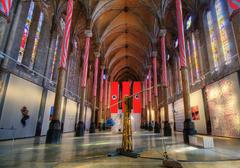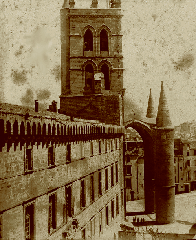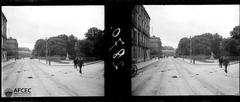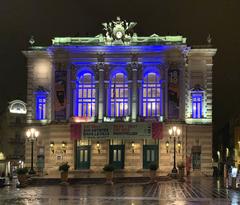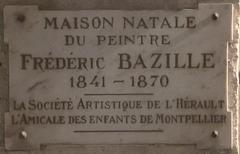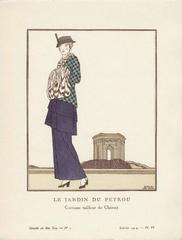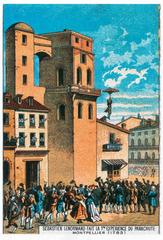Fabre Museum Visiting Hours, Tickets, and Montpellier Historical Sites Guide
Date: 14/06/2025
Introduction
Located in the vibrant center of Montpellier, France, the Musée Fabre stands as a distinguished symbol of European cultural heritage. Founded in 1825 through the generosity of the painter François-Xavier Fabre, this institution has become one of France’s leading provincial art museums, offering visitors a journey through centuries of artistic innovation. The museum’s collections span from Renaissance masterpieces to contemporary works and are housed within a unique blend of historical and modern architecture. With the bicentenary of its founding approaching in 2025, the Musée Fabre is preparing a diverse program of exhibitions and events that reaffirm its role as a dynamic cultural hub (Musée Fabre Official; Montpellier Tourism; Club Innovation Culture).
This guide offers detailed insights into the museum’s history, collections, visitor information—including hours and ticketing—accessibility, and travel tips, along with recommendations for exploring other historical sites in Montpellier.
Table of Contents
- Introduction
- History and Cultural Significance
- Expansion and Architectural Evolution
- Collections Overview
- Visitor Information: Hours, Tickets, and Accessibility
- Travel Tips and Nearby Attractions
- Cultural Programs and Digital Resources
- Frequently Asked Questions (FAQ)
- Conclusion and Call to Action
- References
History and Cultural Significance
The Musée Fabre was established thanks to François-Xavier Fabre, a Montpellier-born painter and member of the French Academy. His initial donation in 1825 formed the nucleus of the museum’s collection, transforming a small municipal assembly of artworks into one of France’s most significant regional museums. Fabre’s bequest inspired further donations, most notably from Antoine Valedau (Dutch and Flemish masters), Alfred Bruyas (Romantic and Realist works), and Jules Bonnet-Mel (drawings and paintings), which cemented the museum’s reputation as a repository of European art (Spotting History).
From its inauguration in the Hôtel de Massilian in 1828, the museum has continued to grow, both in its collections and its architectural footprint, reflecting the evolving spirit and culture of Montpellier.
Expansion and Architectural Evolution
19th–20th Centuries
The museum’s physical expansion paralleled the growth of its collections. The addition of the Galerie des Colonnes (1875–1878) accommodated the Bruyas collection, while further acquisitions saw the integration of neighboring historic hôtels, such as the Hôtel de Lunas and Hôtel de Cabrières-Sabatier d’Espeyran (Montpellier Tourism).
In 1968, Mme Sabatier d’Espeyran’s donation of her hôtel particulier and its contents gave rise to the museum’s decorative arts department, presenting the domestic refinement of 18th- and 19th-century Montpellier (Montpellier Tourism).
21st-Century Modernization
A transformative renovation, completed in 2007 by architects Olivier Brochet and Emmanuel Nebout, unified the museum’s historic and modern wings. The centerpiece, the “Pavilion of Light” (Soulages Wing), with its illuminated glass façade, is dedicated to the abstract painter Pierre Soulages, further enhancing the museum’s contemporary appeal (EUmies Awards). The museum now offers a seamless visitor circuit through interconnected galleries, balancing classical elegance and modern design.
Collections Overview
Old Masters (14th–18th Centuries)
The museum holds exceptional works by Italian, Flemish, Dutch, French, and Spanish masters, including Rubens, Poussin, Veronese, and Bourdon, providing a comprehensive view of European art history (Montpellier Tourism; museefabre.fr).
French Painting (Neoclassicism to Romanticism)
Highlights include masterpieces by David, Ingres, Delacroix, Géricault, and Courbet, illustrating the evolution of French art from the 18th to 19th centuries.
Impressionism and Modern Art
The museum features works by Frédéric Bazille—an Impressionist pioneer born in Montpellier—and artists such as Staël, Van Dongen, and Dufy.
Contemporary Art
A particular strength is the ensemble of more than 20 works by Pierre Soulages, whose abstract paintings explore the interplay of light and darkness. Other notable contemporary artists include Francis Bacon and Joan Miró (beauxarts.com).
Decorative Arts
The Hôtel de Cabrières-Sabatier d’Espeyran presents period rooms filled with fine furniture, porcelain, silverware, and textiles, immersing visitors in the lifestyle of Montpellier’s historical elite (museefabre.fr).
Visitor Information: Hours, Tickets, and Accessibility
- Opening Hours: Tuesday to Sunday, 11:00–18:00; closed Mondays. Hôtel de Cabrières-Sabatier d’Espeyran (decorative arts) open weekends, 14:00–18:00 (museefabre.fr).
- Tickets: General admission is €8; reduced rates (€5) for students, seniors, and groups. Free for children under 18, Montpellier residents under 26, and on the first Sunday of each month. Tickets are available online or at the entrance (museefabre.fr; WhichMuseum).
- Accessibility: The museum is fully accessible, with elevators, ramps, adapted restrooms, and staff assistance (museefabre.fr).
- Facilities: Cloakroom (for small items), restrooms, and free Wi-Fi. No on-site café, but nearby dining options are plentiful.
Travel Tips and Nearby Attractions
- Getting There: Address: 39 Boulevard Bonne Nouvelle, 34000 Montpellier. Access via tram lines 1, 2, and 4 (stations Comédie and Corum). Due to Esplanade Charles de Gaulle works, use Place de la Comédie entrance (museefabre.fr).
- Parking: Paid parking at Parking Comédie (825 spaces) and Parking Corum (490 spaces) (museefabre.fr).
- Cycling: Vélostation self-service bike station nearby.
- Nearby Sights: Enhance your visit by exploring Place de la Comédie, Promenade du Peyrou, Saint-Pierre Cathedral, and Esplanade Charles de Gaulle—all within walking distance (Dreaming in French; guidetoeurope.com).
Cultural Programs and Digital Resources
Bicentenary and Special Events
In 2025, the museum marks its 200th anniversary with an ambitious program, including the commissioning of short films by contemporary artists, a major Pierre Soulages retrospective, and interdisciplinary events spanning lectures, performances, and workshops (Club Innovation Culture; museefabre.fr).
Guided Tours and Educational Activities
Regular guided tours in multiple languages, curator’s tours, thematic visits, and creative workshops are available for all ages. The museum also offers family-friendly programs and resources for schools (museefabre.fr).
Digital Innovation
Mobile applications and interactive devices provide augmented interpretation, while “Fabre dans mon canapé” enables virtual visits and remote learning (museefabre.fr).
Accessibility and Inclusivity
The museum develops tailored projects and materials to ensure access for visitors with disabilities and diverse backgrounds (Club Innovation Culture).
Frequently Asked Questions (FAQ)
Q: What are the Musée Fabre opening hours?
A: Tuesday to Sunday, 11:00–18:00; closed Mondays. Decorative arts open weekends, 14:00–18:00.
Q: How can I buy tickets?
A: Tickets are available online (here) or at the entrance. Advance booking is recommended during busy periods.
Q: Is the museum accessible for visitors with disabilities?
A: Yes, with ramps, elevators, adapted restrooms, and personalized assistance.
Q: Are there guided tours?
A: Regular guided and thematic tours are available. Check the museum calendar.
Q: Can I take photos?
A: Non-flash photography is permitted in permanent collections. Restrictions may apply in temporary exhibitions.
Q: Are children welcome?
A: Yes, with workshops and activities for families, though the museum is best suited for older children.
Conclusion and Call to Action
The Musée Fabre offers a unique experience for art lovers, history enthusiasts, and cultural explorers. From its remarkable collections to its immersive programming and historic setting, the museum is a cornerstone of Montpellier’s cultural identity. With clear visitor information, accessibility, and digital enhancements, planning your visit is easy and rewarding.
For the latest on visiting hours, tickets, and events, consult the official Musée Fabre website. Enhance your experience with the Audiala app for guided tours, and explore related content on Montpellier’s historic and cultural sites.
Visuals and Interactive Resources
- Interactive Map of Fabre Museum Location
- Virtual Tour: Fabre Museum “Fabre dans mon canapé”
- Suggested images: Fabre Museum exterior, gallery interiors, and highlights like the Rubens painting, with alt tags for accessibility.
References
- Spotting History – Musée Fabre History
- Musée Fabre Official – News and Practical Information
- Montpellier Tourism – The Fabre Museum Overview
- Club Innovation Culture – Bicentenary and Artistic Programs
- Infotourisme – Musée Fabre Visitor Information
- EUmies Awards – Architectural Renovation of Musée Fabre
- France Voyage – Musée Fabre
- Dreaming in French – Things to Do in Montpellier
